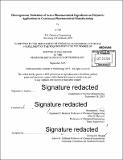Heterogeneous nucleation of active pharmaceutical ingredients on polymers : applications in continuous pharmaceutical manufacturing
Author(s)
Tan, Li, Ph. D. Massachusetts Institute of Technology
DownloadFull printable version (13.87Mb)
Other Contributors
Massachusetts Institute of Technology. Department of Chemical Engineering.
Advisor
Bernhardt L. Trout and Allan S. Myerson.
Terms of use
Metadata
Show full item recordAbstract
In this thesis work, we aimed to explore crystallization processes for small molecule API compounds based on engineered polymer surfaces that could be used in continuous manufacturing. First, we identified a library of polymers that can be used and selected PVA as the model polymer based on its solution and film properties. We also illustrated a rational approach for designing and fabricating PVA film surfaces for increasing heterogeneous nucleation rate of different compounds and enable polymorph selection. The design philosophy was to select prevalent angles between major faces of crystals according to a selection of compounds, and to create substrate surfaces with indentations that include these angles. Nucleation induction time trends showed that heterogeneous nucleation rates were accelerated by at least an order of magnitude in the presence of PVA due to the favorable interactions between the model compounds and the polymer. Nucleation rates were further increased for patterned substrates with matching geometries. Surface indentations with non-matching angles resulted in faster nucleation rates than flat films but slower than matching geometries because they only increased the effective area of the films and their roughness. X-ray diffraction was used to reveal faces that preferentially interacted with the PVA side chains and to deduce possible arrangement of solute molecules at the corners of the indentations. Combining X-ray data and morphology of the crystal product, we suggest that matching geometries on the substrate enhanced nucleation of compounds. In addition to enhancing nucleation rate, polymorph selection was possible in the presence of the polymer substrate to yield a higher percentage of thermodynamically stable gamma indomethacin. Offline Raman experiments and in-line morphology determination confirmed that polymorph control of the final crystal product via kinetic control of the nucleation process was viable. For the aspirin system, the 85 degree angle lead to the highest rate of nucleation; for the polymorphic indomethacin system, XRPD results showed that gamma form preferentially formed on the PVA films with 65 and 80 degree angles leading to the largest reduction in nucleation induction time. Kinetic Monte Carlo simulation showed that a crystallizer incorporating both nucleation and crystal growth in the absence of active mass transfer would have too small a throughput and too large a footprint to be useful. The main reasons were long average nucleation induction times and slow crystal growth in the absence of convection. A set of batch desupersaturation experiments showed that mass transfer limited growth dominate the crystal growth kinetics at low supersaturations when nucleation events were suppressed. An increase in the bulk fluid velocity increased the effective growth kinetics in the system when mass transfer kinetics dominated. Steady state modeling based on the first principle approach was performed using a combination of Navier Stokes Equations and diffusion-convection mass transport equations. The modeling result demonstrated that for mass transfer from a moving fluid to a stationary surface, a thin momentum and concentration boundary layer existed at the leading edge, which resulted in much higher local mass transfer rates. In the absence of momentum boundary layers, mass transfer could only occur via diffusion, which resulted in slow growth kinetics. The first principle model was used to derive dimensionless number correlations for the continuous crystallizer.
Description
Thesis: Ph. D., Massachusetts Institute of Technology, Department of Chemical Engineering, 2015. Cataloged from PDF version of thesis. Includes bibliographical references (pages 92-105).
Date issued
2015Department
Massachusetts Institute of Technology. Department of Chemical EngineeringPublisher
Massachusetts Institute of Technology
Keywords
Chemical Engineering.